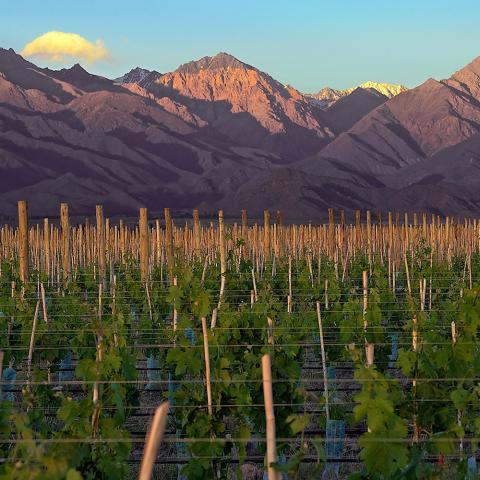Argentina

While there is some wine production in the provinces of Buenos Aires, Córdoba and La Pampa, the vast majority of wine production takes place in the far western expanse of Argentina leading up to the foothills of the Andes. The Mendoza region is the largest region and the leading producer, responsible for more than two-thirds of the country's yearly production, followed by the San Juan and La Rioja regions to the north. In the far northwestern corner of the country are the provinces of Catamarca, Jujuy and Salta which includes some of the world's highest planted vineyards. In the southern region of Patagonia, the Río Negro and Neuquén provinces have traditionally been the fruit producing centers of the country but have recently seen growth in the planting of cool climate varietals (such as Pinot noir and Chardonnay).
Mendoza
Despite total acreage planted declining from 629,850 acres (255,000 hectares) in 1980 to 360,972 acres (146,081 hectares) in 2003, Mendoza is still the leading producer of wine in Argentina. As of the beginning of the 21st century, the vineyard acreage in Mendoza alone was slightly less than half of the entire planted acreage in the United States and more than the acreage of New Zealand and Australia combined.
San Juan & La Rioja
After Mendoza, the San Juan region is the second largest producer of wine with over 116,000 acres (47,000 hectares) planted as of 2003. The climate of this region is considerably hotter and drier than Mendoza with rainfall averaging 6 inches (150 millimeters) a year and summer time temperatures regularly hitting 107 °F (42 °C). Premium wine production is centered on the Calingasta, Ullum and Zonda departments as well as the Tulum Valley. In addition to producing premium red varietals made from Syrah and Douce noir (known locally as Bonarda), the San Juan region has a long history of producing sherry-style wines, brandies and vermouth.
Northwestern regions
The vineyards of the northwestern provinces of Catamarca, Jujuy and Salta are located between the 24th parallel and 26th parallel south and include some of the highest elevated vineyards in the world with many vineyard planted more than 4,900 feet (1,500 meters) above sea level. Two vineyards planted by Bodega Colome in Salta are at elevations of 7,500 feet (2,250 meters) and 9,900 feet (3,000 meters). In contrast, most European vineyards are rarely planted above 1,600 feet (900 meters). Wine expert Tom Stevenson notes that the habit of some Argentine producers to tout the altitude of their vineyards in advertisements and on wine labels as if they were grand cru classifications.
Patagonia
The southern Patagonia region includes the fruit producing regions of Río Negro and Neuquén which has a considerably cooler climate than the major regions to the north which provides a long, drawn-out growing season in the chalky soils of the area. In the early 20th century, Humberto Canale imported vine cuttings from Bordeaux and established the first commercial winery in the region. While 9,300 acres (3,800 hectares) were planted as of 2003, the region is growing as more producers plant cool climate varietals like Chardonnay and Pinot noir as well as Malbec, Semillon and Torrontés Riojano. Many of the grapes for the Argentine sparkling wine industry are sourced from this area. Located more than 990 miles (1,600 kilometers) south of Mendoza, the vineyards of Bodega Weinert are noted as the southernmost planted vineyards in the Americas.



